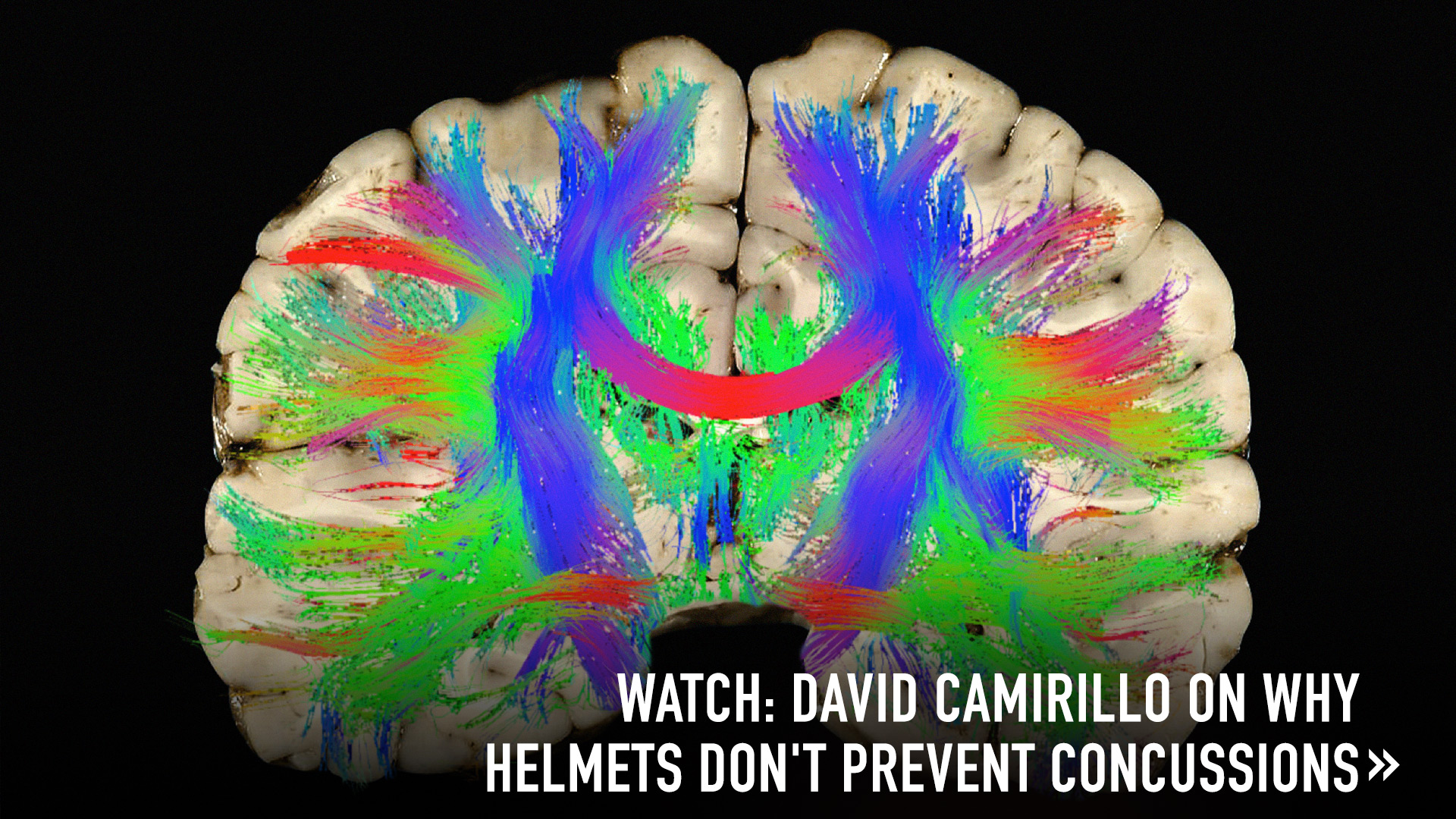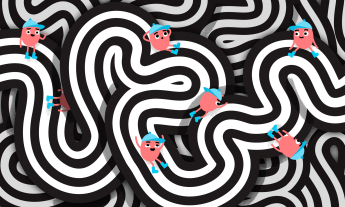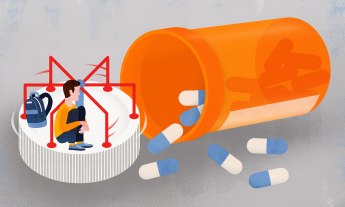
Biomedical engineer David Camarillo reveals how much scientists still don’t know about concussion and the brain.
The word “concussion” evokes more fear than ever, and there’s definitely some evidence to support those fears. We know a repeated history of concussion can lead to chronic changes in the brain’s function and structure, resulting in early dementia and chronic traumatic encephalopathy. But even though football players always shield their heads with helmets before they play, the reality is: Helmets aren’t designed to protect people against concussion, only skull fracture.
I’m a bioengineer, and at my lab at Stanford we’re focused on creating equipment to reduce sports injuries, including traumatic brain injury. Parents ask me all the time, “Should I let my child play football?” yet we’re still a long way from being able to answer that question with any confidence or certainty. Instead, I’m interested in how we can prevent concussions, and whether that’s even possible.
The brain is one of the softest substances in the human body — it’s more like Jell-O. When your head moves back and forth, your brain is twisting, turning and contorting, and its tissue gets stretched.
Many laypeople might not realize that concussion continues to be a mystery to scientists. We have theories about what’s going on in the body, but we haven’t reached an agreement as a field about the precise mechanism of concussion. We know it occurs when a person’s head experiences a sudden movement, usually after impact, that causes the brain to be jolted. The skull moves first, and then the brain catches up and oscillates back and forth. The brain probably moves very little inside the skull — there are only a few millimeters of space in the cranial vault — and it’s filled with cerebrospinal fluid, which acts as a protective layer.
Most people imagine the brain during a concussion as moving inside the skull as a rigid object, like a ball bouncing around. But the brain is one of the softest substances in the human body — it’s more like Jell-O. When your head moves back and forth, your brain is twisting, turning and contorting, and its tissue gets stretched. And while you might expect the damage from a concussion to occur on the brain’s outer surface, most experts now agree its effects happen much deeper towards the center of the brain.
What’s impeded our understanding has been a lack of firsthand data. Since there hasn’t been a way to know how a living person’s brain moves inside their body, scientists have had to settle for studying cadavers. More recently, however, researchers have experimented with attaching sensors to helmets, scalps and people’s skin. At my lab, we’ve found the most reliable device to be a special mouthguard. It contains sensors, specifically accelerometers and gyroscopes, which are essentially the same as the ones in your cell phone. When someone is struck in the head, the device can measure the motion of the head every 1/1000th of a second. The mouthguard fits onto the teeth, which are the hardest substances in the body, and because the teeth are rigidly coupled to the skull, this can give us a very precise measurement of how the skull moves. The device’s gyroscopes allow us to measure the rotation of the head, which is what most experts think is the critical factor during concussion.
For our research, we had to find a group of volunteers to wear the mouthguards who were willing to go out and smash their heads into each other on a regular basis and sustain concussion. We had a ready pool of subjects: the Stanford football team. We combine information from the mouthguards with video footage of collisions, and the data we’ve gotten so far has been rich and sometimes expected. For example, in one game we saw a player sustain a hard hit in the lower left side of his face mask. But instead of his head doing what we might have predicted — moving to the right — it first rotated to the left. We learned this from the mouthguard data. Then, as his neck began to compress, the force of the blow caused it to whip back to the right. This left-right motion was almost like whiplash, and we think that movement is probably what led to his brain injury.
The mouthguard is limited to measuring the motion of a person’s skull, however, and we really want to know what’s happening inside it to the brain. So my lab has collaborated with Svein Kleiven and his team at the KTH Royal Institute of Technology in Sweden. They’ve developed a finite element model of the brain, which uses a computer to simulate the physics of the brain and show where the stresses and strains regionally occur. Using data from the mouthguards and through their simulation, we can see how the brain twists and contorts, with colors indicating how much the brain tissue is being stretched relative to its original length. In this image, the red color indicates 50 percent, and as you can see below, a large part of the red area is close to the center of the brain.

Researchers in my lab and others have observed a concussion is more likely to occur when a person is struck and their head rotates in a left-right direction. This happens more often in sports like football than in, say, cycling. The human brain, more so than other animals, has two large lobes: the left brain and right brain. Right down the center between the two lobes is a large fissure that goes deep into the brain. In that fissure is a fibrous sheet of tissue called the falx — it runs from the front of the head all the way to the back. It is quite stiff, so when the head is struck and rotates in a left-right direction, that force is rapidly transmitted right down the center of the brain. At the bottom of the fissure is the wiring of the brain, including the single largest fiber bundle that connects the lobes. It’s called the corpus callosum.
We think this may be one of the most common mechanisms of concussion — as the forces of impact move into the brain, they strike the corpus callosum, causing a dissociation between the right and the left brain. This could explain some of the symptoms of concussion, and it’s also consistent with the damage we’ve seen in chronic traumatic encephalopathy. Below is an image of the brain of a middle-aged ex-professional football player, and you can see the corpus callosum has greatly atrophied. The same has occurred to the space in his ventricles, which are neural cavities and they appear much larger in the ex-player’s brain than in the normal brain. All of the tissue near the center of his brain has died off over time after repeated impacts.

Because we know it takes a defined amount of time for the forces to travel to the corpus callosum and affect it, we think if we can slow the head down just enough so the brain does not lag behind the skull but moves in synchrony with it, we might be able to prevent this mechanism of concussion. But how can we slow it down?
Our lab has been collaborating with a company in Sweden called Hövding on a device that attempts to counteract this mechanism in bicyclists. Instead of a helmet, their device is a neck collar. Its designers have put sensors in it that are similar to those on our mouthguard, and they detect when a person is likely to have a fall. When they do, an airbag in the collar explodes and triggers, essentially the same way an airbag works in your car. In the experiments we’ve done in my lab with this device, we’ve found it can greatly reduce the risk of concussion in some scenarios compared to a standard bicycle helmet.
This device is for sale in Europe but not in the US, because it would need to pass stringent federal regulations first. Bike helmets in the US fall under the jurisdiction of the Consumer Product Safety Commission (CPSC). The CPSC evaluates bike helmets for efficacy in preventing skull fracture, and this neck collar would not pass that test. But while a fracture test is an important one and can help save lives, it does not account for concussion prevention. The US government would need to entirely rethink its standards to approve this collar, and I doubt that will happen anytime soon. Even though football helmets aren’t regulated by the CPSC — they are assessed by an industry body — they’re subjected to a similar test that measures only for fracture prevention.
Despite all the challenges, I’m optimistic for a few reasons. Although scientists don’t yet agree on the mechanism of concussion, more and more work is being done in the area which should eventually yield enough human data so we can reach a consensus. In September 2016, the NFL announced it is dedicating $40 million towards studying brain injuries and $60 million to helmet development, funds that should accelerate research and and innovation. Efforts shouldn’t be limited to the relatively small group of athletes in the NFL, of course; we should also seize the opportunity to understand and prevent concussion in America’s 3 million younger football players. While it may take decades, I believe someday we’ll finally be able to answer to the question “Should my kid play football?”













